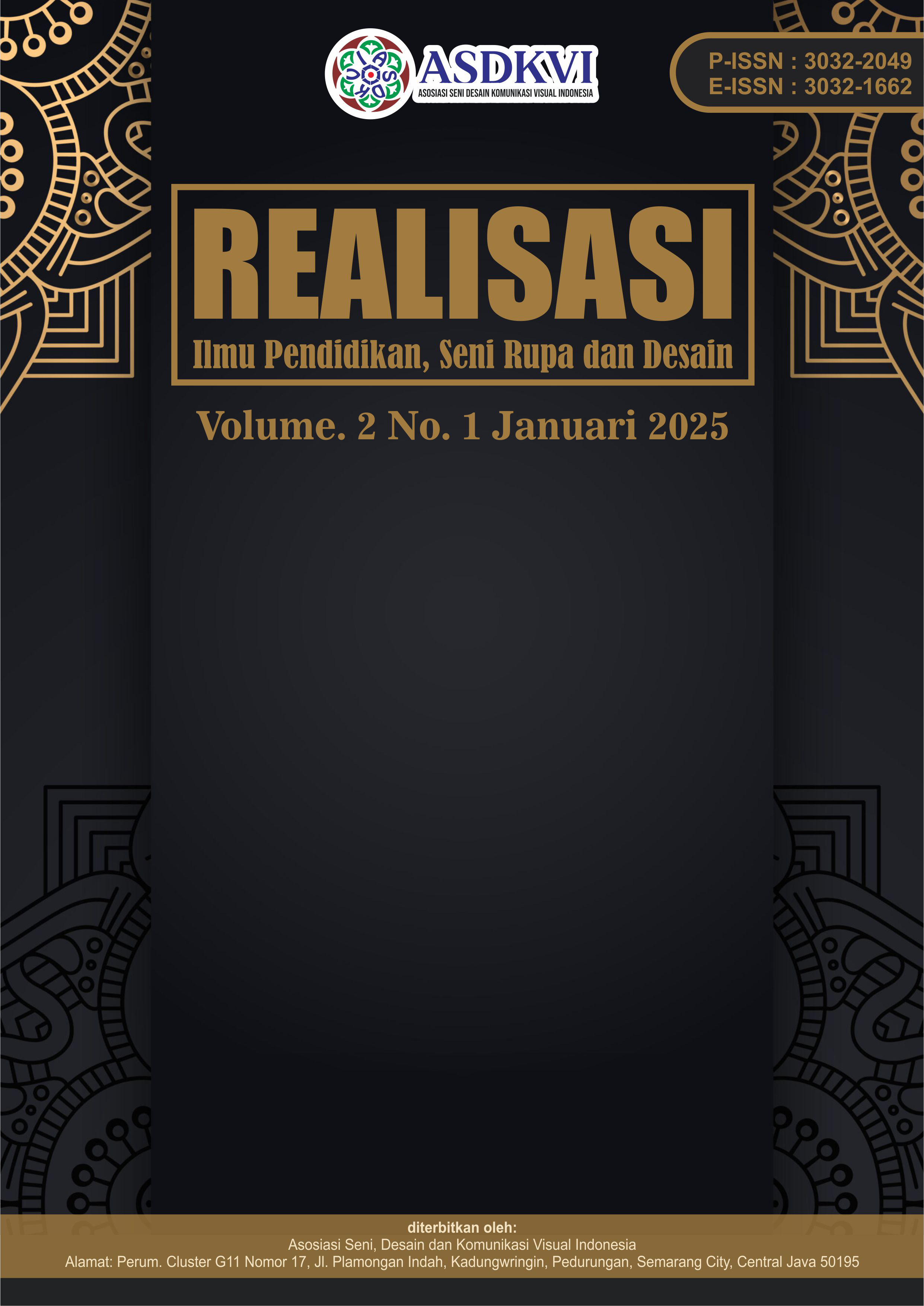Penciptaan Outer Batik Dengan Teknik Batik Tulis, Shibori dan Ecoprint
DOI:
https://doi.org/10.62383/realisasi.v2i2.571Keywords:
Batik Outerwear, End Ecoprint, Shibori, Written BatikAbstract
The creation of batik outerwear combines three techniques: hand-drawn batik (batik tulis), shibori, and ecoprint, to produce designs that are both functional and aesthetically rich, while promoting local cultural identity. The process follows the Art Creation Methodology, consisting of four stages: exploration, experimentation, realization, and evaluation. In the exploration phase, the techniques used are studied, and how their combination can create unique motifs. This phase also includes an in-depth understanding of the history and philosophy of each technique, ensuring a strong foundation for their application in the design of the outerwear.In the experimentation phase, various patterns, colors, and compositions are tested to determine the best combination of the three techniques. This stage involves creating several design samples to test the harmony between hand-drawn batik, the visually appealing folds of shibori, and the natural impressions left by ecoprint leaves. Then, in the realization stage, the batik outerwear is completed by integrating these elements into a cohesive design. The techniques of batik tulis, shibori, and ecoprint work together to create rich textures and motifs.In the evaluation phase, the aesthetic and functional quality of the final product is assessed. The final result demonstrates that combining these techniques not only creates unique designs but also adds value in terms of beauty and sustainability, while supporting the preservation of local culture through innovation in batik art.
References
Adisurya, S. I., dkk. (2023). Penerapan ecoprint dengan metode pounding pada produk bernilai jual bagi remaja karang taruna. AKSARA: Jurnal Ilmu Pendidikan Nonformal, 9(2), 1057-1066.
Amijaya, S. Y., dkk. (2023, October). Pelatihan teknik shibori dengan pewarnaan alami bagi komunitas warga paroki Brayut. In Prosiding Seminar Nasional Pengabdian Kepada Masyarakat, 4, SNPPM2022EK-228–SNPPM2022EK-241.
Atmojo, W. T., & Misgiya. (2018). Eksplorasi dan implementasi ornamen Sumatera Utara dalam karya batik. Artchive: Indonesia Journal of Visual Art and Design, 1(1), 1-7.
Atmojo, W. T., dkk. (2012). Penciptaan batik Melayu Sumatera Utara. Jurnal Seni dan Budaya Panggung, 23(1), 90-97.
Atmojo, W. T., Misgiya, & Wiratma, S. (2019). Batik: Eksplorasi kearifan lokal: Ornamen Sumatera Utara. CV. Kencana Emas Sejahtera.
Eskak, E. (2022). Teknik dan desain produk ecoprint dalam berbagai material baru (non tekstil). In Prosiding Seminar Nasional Industri Kerajinan dan Batik, 4(1), D08-1–D08-15.
Faridatun, F. (2022). Ecoprint: Cetak motif alam ramah lingkungan. Jurnal Prakarsa Paedagogia, 5(1), 230-234.
Fitriyah, S. H., & Ramadhani, N. L. (2024). Buku panduan penerapan teknik shibori. Universitas Ngudi Waluyo.
Gartha, & Benny. (2013). Panduan pembuatan kain ikat celup bagi pemula. Museum Tekstil.
Hamzuri. (1981). Batik klasik = Classical batik (J. Achjadi, Trans.). Djambatan.
Humaeroh, Z., dkk. (2023). Pewarna ecoprint dari tumbuh-tumbuhan. Detak Pustaka.
Kawamura, Y. (2005). Fashion-ology: An introduction to fashion studies. Berg.
Kurniawan, A., & Hidayatullah, R. (2016). Estetika seni. Arttex.
Maziyah, S., dkk. (2019). Implementasi shibori di Indonesia. Kiryoku, 3(4), 214-220.
Prawira, N. G. (2018). Budaya batik Darmayon. PT. Sarana Tutorial Nurani Sejahtera.
Rachmadhani, D. A. V., & Febriani, R. (2020). Perancangan outer dengan konsep modest travel wear untuk wanita travelling pada musim gugur. eProceedings of Art & Design, 7(2), 3840-3853.
Ristiani, S., & Sulistyaningsih, T. (2020). Tritik jumputan inovatif: Cantik, unik, dan kreatif. Penerbit Andi.
Saragi, D., & Sembiring, D. (2014). Buku ajar estetika (Tinjauan seni dan keindahan). Unimed Press.
Saragi, D., dkk. (2022). Metode penelitian kesenirupaan. Jurusan Seni Rupa Fakultas Bahasa dan Seni Universitas Negeri Medan.
Saraswati, R., dkk. (2019). Pemanfaatan daun untuk ecoprint dalam menunjang pariwisata. Depok: Departemen Geografi FMIPA Universitas Indonesia.
Saribanon, N., dkk. (2020). Pengenalan teknik membatik dengan pewarna alam bagi penyandang disabilitas. Institut Pengembangan Masyarakat (IPM).
Sedjati, D. P., dkk. (2018). Mix teknik ecoprint dan teknik batik berbahan warna tumbuhan dalam penciptaan karya seni tekstil. Corak Jurnal Seni Kriya, 8(1), 1-11.
Sp, Gustami. (2004). Proses penciptaan seni kriya “Untaian metodologis”. Program Penciptaan Seni Pascasarjana. Institut Indonesia Yogyakarta.
Steelyana, W. (2012). Batik, a beautiful cultural heritage that preserves culture and supports economic development in Indonesia. Binus Business Review, 3(1), 116-130.
Suantara, D., dkk. (2017). Shibori technique exploration in developing Indonesian traditional motif design in clothing fabric surface. Arena Tekstil, 32(2), 67-76.
Wulandari, A. (2011). Batik Nusantara. Andi.
Yulianingrum, V., dkk. (2022). Batik fashion trends and national identity. Philosophica: Jurnal Bahasa, Sastra, dan Budaya, 5(2), 46-58.
Downloads
Published
How to Cite
Issue
Section
License
Copyright (c) 2025 Realisasi : Ilmu Pendidikan, Seni Rupa dan Desain

This work is licensed under a Creative Commons Attribution-ShareAlike 4.0 International License.





